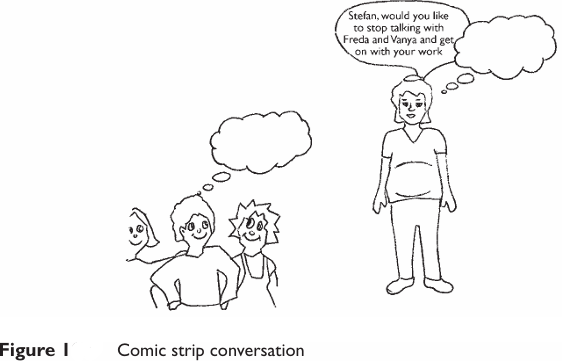
Learner participation
 المؤلف:
Mike Blamires
المؤلف:
Mike Blamires
 المصدر:
Additional Educational Needs
المصدر:
Additional Educational Needs
 الجزء والصفحة:
P149-C10
الجزء والصفحة:
P149-C10
 2025-04-21
2025-04-21
 474
474
Learner participation
Much recent legislation has emphasized the importance of the learner’s voice in making provision. Within the area of ASD, this can be difficult because the learner cannot readily reflect upon their experiences, especially if they are anxious after they have been involved in an incident and you are enquiring about what happened and why. As well as observation and discussion with the teacher and parents about the possible reasons for a behavior, a technique Carol Gray called comic strip conversations has been widely used. This involves the use of colored felt tip pens, the drawing of stick men with cartoon speech and thought bubbles to denote what was said and what people may have thought (Figure 1). This can be used to discover what happened leading up to an incident, so the child has an external and literal representation of what was said and meant. The colored pens are used to code the emotion of what was said. For example:

learner cannot readily reflect upon their experiences, especially if they are anxious after they have been involved in an incident and you are enquiring about what happened and why. As well as observation and discussion with the teacher and parents about the possible reasons for a behavior, a technique Carol Gray called comic strip conversations has been widely used. This involves the use of coloured felt tip pens, the drawing of stick men with cartoon speech and thought bubbles to denote what was said and what people may have thought (Figure 1). This can be used to discover what happened leading up to an incident, so the child has an external and literal representation of what was said and meant. The coloured pens are used to code the emotion of what was said. For example:
RED: Bad ideas, teasing anger, unfriendly
BLACK: Facts, things we know
GREEN: Good ideas, happy, friendly
Discussion
In Figure 1, what do you think the teacher is thinking and trying to communicate. What is the child likely to say?
With older learners, a conversation might be carried out using a word processor so that the learner with ASD can focus upon the questions and their answers. Sometimes this can be just with the adult typing.
 الاكثر قراءة في Teaching Strategies
الاكثر قراءة في Teaching Strategies
 اخر الاخبار
اخر الاخبار
اخبار العتبة العباسية المقدسة


